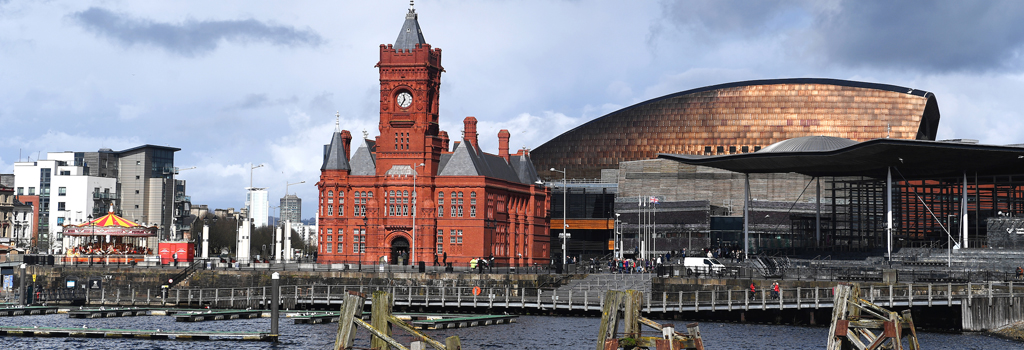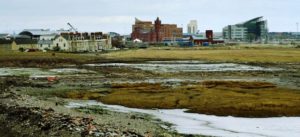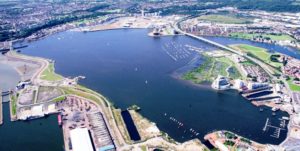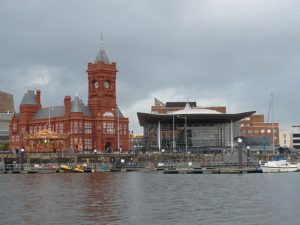There’s a lot of revitalization happening in Cardiff, Wales these days. So much that we’ve got two articles about Cardiff in this issue. This one is a 30-year retrospective of how the entire waterfront came to be redeveloped. The other article focuses just on the High Street.
Cardiff Bay is the area of water created by the Cardiff Barrage in south Cardiff, the capital of Wales. It is also the name commonly given to the areas of the city surrounding the Bay.
Of course, like most engineered water-control projects, the Barrage was hugely destructive from an ecological standpoint. But despite vociferous opposition by environmentalists and wildlife organisations, the mudflats at the mouths of the River Taff and River Ely were inundated, with tremendous loss of habitat for wading birds.
Since then, the several new habitats have emerged for freshwater species in the wetlands to the south of the Hamadryad Park, as a result of the changed hydrology.
But wildlife’s lost was the local human residents’ gain. The creation of Cardiff Bay is now widely regarded as one of the most successful regeneration projects in the United Kingdom.
The Bay is a 500-acre (2.0 km2) freshwater lake around the former dockland area south of the city center. Since the Bay was formerly tidal, access to the sea was limited to a couple of hours each side of high water. Now, 24-hour access is provided via three locks.
In the 1980s, Cardiff Bay—once the epicentre of Wales’ booming coal and export industries—had become an abandoned wasteland of derelict docks and mudflats.
A victim of a dramatic fall in trade following World War Two and competition from other ports saw its decline and a plan was put in place to bring it back to life and reconnect it to the city center.
The Cardiff Bay Development Corporation (CBDC) was created in April 1987 to regenerate over 1100 hectares (2,700 acres) of dockland between Cardiff and Penarth.
It was part of the British government’s Urban Development Programme, which was designed to regenerate deprived areas of inner cities, its aim was to “put Cardiff on the international map” and boost the image and economic wellbeing of the area.
The CBDC’s main objectives were to:
- promote development and provide an environment where people want to live, work and play;
- reunite the city center with its waterfront;
- build a mixed development to create jobs;
- achieve the highest standard of design and quality in its development and investment; and
- establish the area as a recognized center of excellence in urban regeneration.
The main catalyst for regeneration came with proposals for the £220 million barrage. The structure was needed to trap water from the extremely tidal Severn estuary, without which the bay would be without water for much of the day at low tide. Completed in 1999, the barrage was one of the largest engineering projects in Europe, creating a permanent 200-hectare freshwater lake.
Along with it came the economic revitalization: initially it was shops, bars and restaurants along Mermaid Quay, overlooking the bay. Later came the construction of Lloyd George Avenue, which reconnected the waterfront to the city center.
Recalling the cold, wet day when he first went to asses what could be done to revitalise the area, Lord Crickhowell remembers a “vast area of dereliction“.
Roger Thomas, former chairman of Cooke and Arkwright chartered surveyors, which helped advise on the feasibility of the early redevelopment, said the CBDC had left a legacy to be proud of: “I hate to think what Cardiff would be like if it hadn’t been done.”
But, Lord Crickhowell, the man behind the successful reinvention of the former derelict docklands 30 years ago says future redevelopment of Cardiff Bay needs a more coordinated approach to ensure its success. He is fiercely opposed to the latest plans to redevelop land for apartments, which includes a 24-story building.
Three decades after he sparked plans for one of the biggest overhauls the city has seen, it’s time to ascertain what has been achieved.
Featured photo courtesy of Visit Wales.





